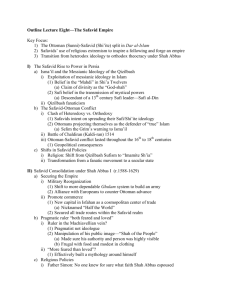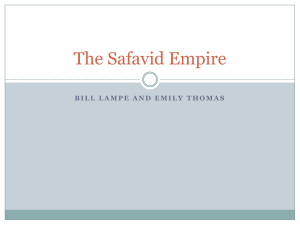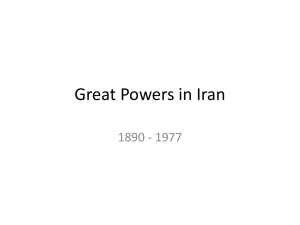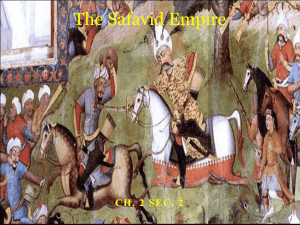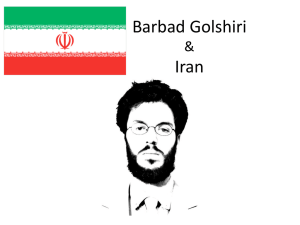Iranian History
advertisement
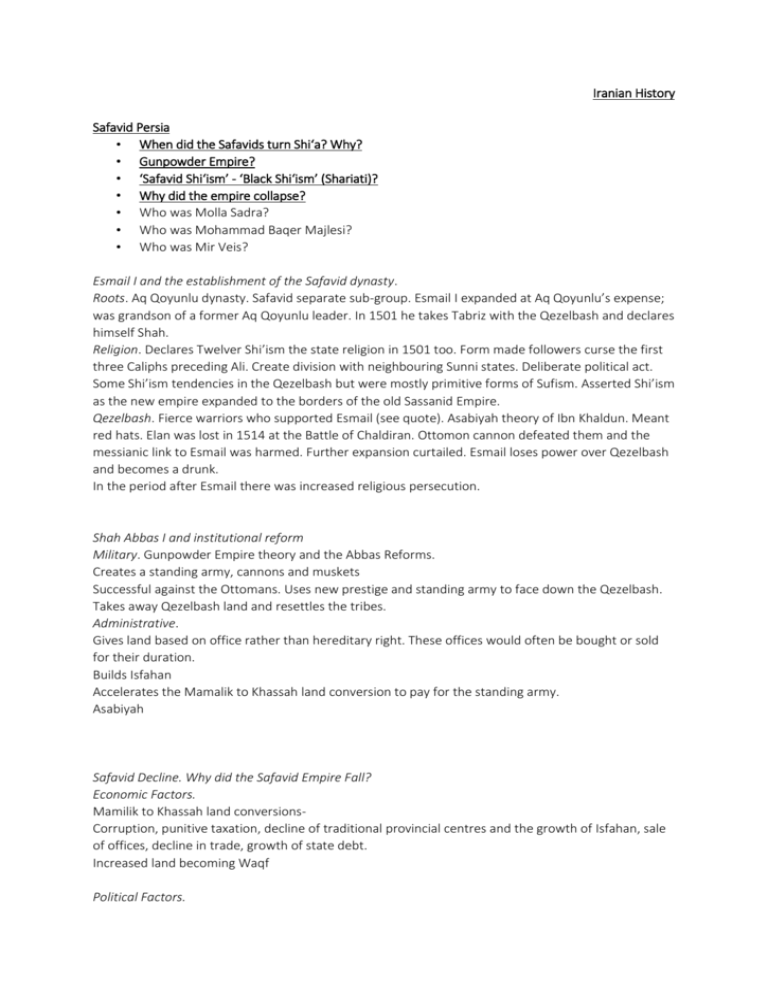
Iranian History Safavid Persia • When did the Safavids turn Shi‘a? Why? • Gunpowder Empire? • ‘Safavid Shi‘ism’ - ‘Black Shi‘ism’ (Shariati)? • Why did the empire collapse? • Who was Molla Sadra? • Who was Mohammad Baqer Majlesi? • Who was Mir Veis? Esmail I and the establishment of the Safavid dynasty. Roots. Aq Qoyunlu dynasty. Safavid separate sub-group. Esmail I expanded at Aq Qoyunlu’s expense; was grandson of a former Aq Qoyunlu leader. In 1501 he takes Tabriz with the Qezelbash and declares himself Shah. Religion. Declares Twelver Shi’ism the state religion in 1501 too. Form made followers curse the first three Caliphs preceding Ali. Create division with neighbouring Sunni states. Deliberate political act. Some Shi’ism tendencies in the Qezelbash but were mostly primitive forms of Sufism. Asserted Shi’ism as the new empire expanded to the borders of the old Sassanid Empire. Qezelbash. Fierce warriors who supported Esmail (see quote). Asabiyah theory of Ibn Khaldun. Meant red hats. Elan was lost in 1514 at the Battle of Chaldiran. Ottomon cannon defeated them and the messianic link to Esmail was harmed. Further expansion curtailed. Esmail loses power over Qezelbash and becomes a drunk. In the period after Esmail there was increased religious persecution. Shah Abbas I and institutional reform Military. Gunpowder Empire theory and the Abbas Reforms. Creates a standing army, cannons and muskets Successful against the Ottomans. Uses new prestige and standing army to face down the Qezelbash. Takes away Qezelbash land and resettles the tribes. Administrative. Gives land based on office rather than hereditary right. These offices would often be bought or sold for their duration. Builds Isfahan Accelerates the Mamalik to Khassah land conversion to pay for the standing army. Asabiyah Safavid Decline. Why did the Safavid Empire Fall? Economic Factors. Mamilik to Khassah land conversionsCorruption, punitive taxation, decline of traditional provincial centres and the growth of Isfahan, sale of offices, decline in trade, growth of state debt. Increased land becoming Waqf Political Factors. The Harem and Government Spending The Ulema and factionalism Military Factors. Loss of the Battle of Golnabad Disaster Myopia ‘Tribal resurgence’ Isolation of the Shahs due to the declining importance of tribes/provinces in military service and the economy. Failure to ensure the sustainability of the Abbas reforms. Molla Sadra- Born 1571 or 1572 in Shiraz. Studied under Mir Damad and Shaikh Baha’i Conventional religious studies, but also philosophy (Avicenna, neo-Platonism) and Sufism (Sohravardi, Ibn Arabi) Most famous book al-Afsar al-arba’a - Four Journeys. Some opposition from traditional ulema. But develops idea of Erfan - a form of mysticism that fits within the traditional rationalist education of the madrasehs Mohammed Baqer Majlesi- Comes to prominence in the reign of Shah Soleiman Profuse writings, in Persian as well as Arabic. Important for assembling large number of traditions (hadith) of the Shi‘a Emams But also encourages strict adherence to Shi‘a orthodoxy, persecution of Sufis, Sunnis, Jews (disputed), Hindus. Becomes prime mojtahed (Shaikh ol-Eslam) after death of Shah Soleiman Majlesi presides at coronation of Shah Sultan Hosein , decree issued that he must be obeyed in all matters, that taverns should be closed, prostitution, alcohol, music, dancing and gambling be banned. Women to dress modestly and stay at home Afghan Revolt Mir Veis- Led by Hotaki Ghilzai Afghan of Kandahar, Mir Veis. Ghilzais are Sunni, Pashto-speakers. Ghilzais revolt against the Georgian governor in 1709, kill him and defeat the armies sent by the Safavid government to crush the revolt. Abdali tribes, rivals of the Ghilzais, based in Herat, revolt too. Revolts or disturbances develop also in Shirvan, Kurdistan, Khorasan, Baluchistan and Bahrain. Sunni provinces. Mir Veis dies during the revolt. Government in Isfahan fails to respond forcefully to crisis. Factions at court manouevre to obstruct any energetic statesman who may arise. 1719 - Kerman sacked by Mahmud Ghilzai (son of Mir Veis). Fath Ali Khan Daghestani (Sunni) as vizier - deposed by a conspiracy, blinded and tortured to reveal where his valuables were hidden. Replaced as vizier by Mohammad Qoli Khan Shamlu - ineffectual. Mahmud Ghilzai attacks again in 1721. Kerman suffers terrible siege but holds out and governor bribes Mahmud to move on. Fails to take Yazd - moves on again toward Isfahan Safavid army confronts him at Golnabad - 8 March 1722. Fights hard but commanders fail to coordinate. Persians defeated - Isfahan besieged. Population suffers terribly. Shah Sultan Hosein surrenders city October 1722 and abdicates Mahmud Ghalzai becomes Shah Past Questions: How did Shah Abbas transform the Safavid monarchy? Did the positive outcomes outweigh the negative? Explain the origin of the Qezelbash and the changing nature of their relationship with the Safavid dynasty. Did Shah Abbas I succeed in transforming his Empire into what Marshall G Hodgson called a Gunpowder Empire? Source based questions. Extract, Author, Ideas, Significance. “My name is Shah Esma‘il. I am on God’s side: I am the leader of these warriors. My mother is Fatima, my father Ali: I too am one of the twelve Emams. I took back my father’s blood from Yazid. Know for certain that I am the true coin of Haydar [ie Ali] Ever-living Khezr, Jesus son of Mary I am the Alexander of the people of this age Chardin- The highest throne of the universe is only fit for a mouchtehed (mojtahed), someone who possesses more holiness and knowledge than common people. Since the mouchtehed is holy, and consequently a peaceable person, a king is needed who can wield the sword to exercise justice, but he can only be his [the mojtahed’s] minister and must be dependent on him. Reza Shah • How did Reza Khan come to power? • Did his reforms succeed or fail ? • How/why did he lose power? Rise to power Reza Khan becomes Army C in C after coup. Defeats Kuchek Khan and Jangalis. Further campaigns to pacify tribes Makes himself PM 1923. Keeps support of conservative elements of Majles Attempts to set up republic 1924 – fails. Visits Najaf 1925, takes name Pahlavi. Ahmad Shah deposed end 1925, Reza crowned Shah early 1926. Significance - Reza fulfils modernising, nationalist aims of Const. Rev at the expense of the liberal, democratic aims. Initially, allies with Const. politicians. Later, more autocratic. Ministers removed, imprisoned, murdered. Military Reforms Central to Shah’s programme. Enforces central govt control (Weber). Army of 40-50,000 in 20s, 100,000 by end 30s. Oil money goes on equipment But - conscripts. Badly paid, low morale. Provincial governors still employ tribal levies. Oil D’Arcy concession 1901: oil discovered 1908 (in Khuzestan, near the Iraqi border). Oil vital to British navy and to Imperial strategy. D’Arcy concession - 16% of AIOC profits to Iran. Teymurtash announces renegotiation 1928. Shah cancels concession unilaterally 1932. British pressure. Shah sacks Teymurtash (murdered in prison 1933). New settlement - Iranian govt gets 20% End of Reza Shah’s Reign Reza Shah admires and imitates Atatürk (republic episode). Nationalist, statist, westernising, secularist (language, military, anti-imperial). Visits Turkey 1934 BUT Still a monarchy. Ulema still powerful, and v unhappy. Oil still in foreign hands. Reza Shah lacks charisma of Atatürk. By late 30s, Reza Shah has lost all support. Mohammed Reza Shah Mossadeq- Development of mass politics post-war There were 47 newspapers in Tehran by 1943; 700 by 1951: Radio too. Tudeh founded 1941; banned 1949. Prime Minister Razmara assassinated 1951. Mohammad Mossadeq comes to power Nationalist, main objective oil nationalisation. British, US opposition. Mossadeq tries also to limit power of monarchy Coup August 1953, initially fails, renewed demos succeed. After 1953 coup, Shah rules personally. US dominant foreign power AIOC dominance broken. Leading clerics (Borujerdi, Kashani) support Shah Shah pursues land reform Population expands: 15m 1938; 19.3m 1950; 27.3m 1968; 33.7m 1976. Economy grows 7-8% per year average 1954-1969 But economy falters 1960-61, clergy oppose land reform. Demos and strikes Khomeini emerges after death of Borujerdi 1961. Khomeini attacks govt corruption, neglect of poor, alignment with US. Deported 1964 Islamic Revolution Iran since 1979 Iran-Iraq War Saddam invades because of a) Arab populations in border regions inc. oil rich Khuzestan. b) The Shatt al-Arab Dispute and the Algiers Accords
